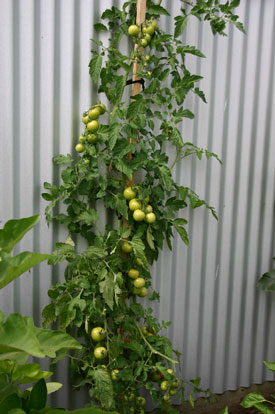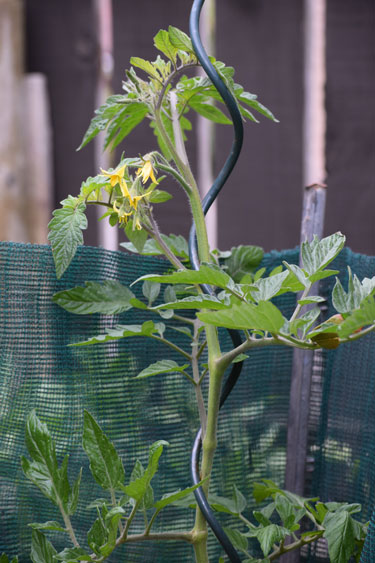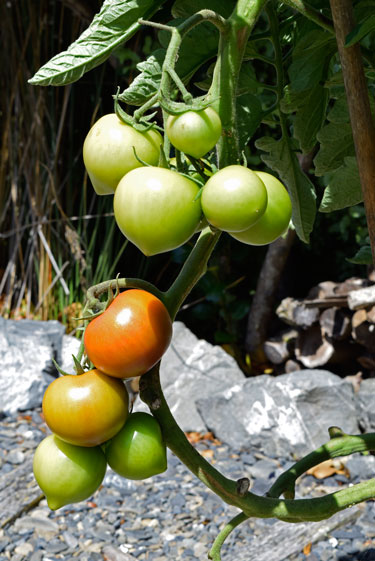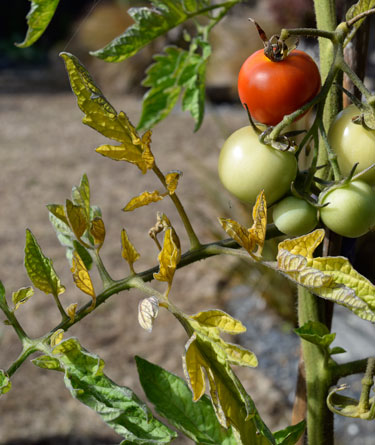Grow beautiful tomatoes
To grow beautiful tomatoes you will need ...
- Warm sunny weather - tomatoes need a good few months of warm frost-free weather. It’s risky to plant them outdoors before the last expected frost, but do make the most of the growing season by getting them in well before Christmas. November is a great time to plant. Give them shelter from cold winds, but some air movement is important as still humid air invites disease.
- Good clean soil (or planting mix) - tomatoes need a well-drained soil that holds a non-stop supply of water and nutrients. Add lots of compost before planting. To minimise disease problems you should plant in soil that has not had tomatoes or any of their relatives (potatoes, peppers, eggplants) grown in it for at least two seasons. If that’s not possible, dig out the soil and replace it with fresh planting mix from the garden centre or soil from elsewhere in the garden. Alternatively plant your tomatoes in large containers or bags.
- Seeds or seedlings - in warm climates it’s not too late to start your tomatoes from seed, but a huge range of tomatoes are available as seedlings or grafted plants.
- Stakes - install stakes at planting time to avoid damaging the roots later.
- Tomato food - tomatoes love to be fed. Apply general fertiliser or sheep pellets at planting time and then, when the tiny fruit appears, start feeding with a high potassium fertiliser. The easiest way to be sure of the best balance of nutrients, is to use a fertiliser especially made for tomatoes. Home made brews from comfrey leaves (high in potassium) and seaweed are very effective, but care is needed not too make these too concentrated. Fish manure also give good results. Seaweed makes excellent mulch. For tomatoes in containers, mix in slow release fertiliser at planting time and feed weekly with liquid fertiliser.
- Water - tomatoes need constant moisture. Water new plants an hour or so before planting. Water again after planting and finish off with organic mulch to conserve moisture. Once plants are growing strongly, deep infrequent watering is better than a daily sprinkle. Thoroughly soak the ground to train roots to grow deep into the soil.
Tomato training
As your tomatoes grow they need training to get the best yields and reduce disease problems ...
- Tall varieties that produce fruit continuously over many weeks are best trained on stakes or wires to encourage manageable upright growth. Remove the little side shoots (called laterals) that appear between each leaf and the main stem. Do this every few days as the plant grows, lightly tying the new top growth to the stake with flexible ties (old nylon stockings cut in strips are ideal). Guard against disease entry by removing laterals only on a dry sunny day.
When the plant has reached the desired height or has a dozen or so good trusses of fruit, remove the growing tip at the top of the plant. This diverts energy back into the developing fruit. Although the plant needs its foliage to make energy for growing fruit, removing lower leaves helps promote air circulation. - Dwarf varieties yield one main crop all at once. They’ll produce more fruit without pruning, but foliage that becomes diseased or overcrowded should be removed. Protect the fruit from contact with the soil by planting through weed mat or mulching with straw. Alternatively, grow them in containers.
Tomato troubles
- To spray or not to spray? The decision is yours. In warm humid conditions tomatoes invite a range of of diseases and your garden centre can help you choose a remedy. However, you can at least cut down on spraying by giving them the best soil, water and feeding for strong vigorous growth and by taking some preventative measures:
- Start with a disease resistant variety. Buy fresh seed or seedlings from a reputable supplier. Seed saved from a previous crop may carry over disease to the next crop. Grafted tomatoes have disease resistant rootstock.
- Don’t plant tomatoes in the same soil in consecutive years (see point 2 above). Never remove tomato laterals on a wet or humid day.
- Remove lower leaves if they become diseased. This also helps with air circulation. Dab with Yates Tomato Dust when removing laterals or cutting off leaves.
- Avoid overhead watering. Apply water at ground level. Mulch to cut down on watering and deter weeds (which harbour disease!).
- Spray regularly with copper to prevent disease, especially in humid conditions.
- The tomato psyllid is a serious pest of tomatoes, potatoes, and capsicums, which is almost impossible to control without spraying. The insects suck the sap from the plant while infecting it with a harmful bacteria. The first symptoms are yellowing, stunted and curling top leaves. Flowers fall and fruit is small and misshaped. Spray with Yates Mavrik.
3-Nov-2012

Tomato vine staked

Young tomato well supported and sheltered from wind

Remove older leaves from around the fruit trusses to improve ripening

Hungry leaves, an early sign of the tomato-potato psyllid attack


